Abstract
The ability of cocaine to inhibit the dopamine transporter (DAT) appears to be crucial for its reinforcing properties. The potential use of drugs that produce long-lasting inhibition of the DAT as a mean of preventing the "high" and reducing drug-seeking behavior has become a major strategy in medication development. However, neither the relation between the high and DAT inhibition nor the ability to block the high by prior DAT blockade have ever been demonstrated. To evaluate if DAT could prevent the high induced by methylphenidate (MP), a drug which like cocaine inhibits the DAT, we compared the responses in eight non-drug-abusing subjects between the first and the second of two MP doses (0.375 mg/kg, i.v.) given 60 min apart. At 60 min the high from MP has returned to baseline, but 75-80% of the drug remains in brain. Positron-emission tomography and [11C]d-threo-MP were used to estimate DAT occupancies at different times after MP. DAT inhibition by MP did not block or attenuate the high from a second dose of MP given 60 min later, despite a 80% residual transporter occupancy from the first dose. Furthermore some subjects did not perceive a high after single or repeated administration despite significant DAT blockade. These results indicate that DAT occupancy is not sufficient to account for the high, and that for DAT inhibitors to be therapeutically effective, occupancies > 80% may be required.
Full text
PDF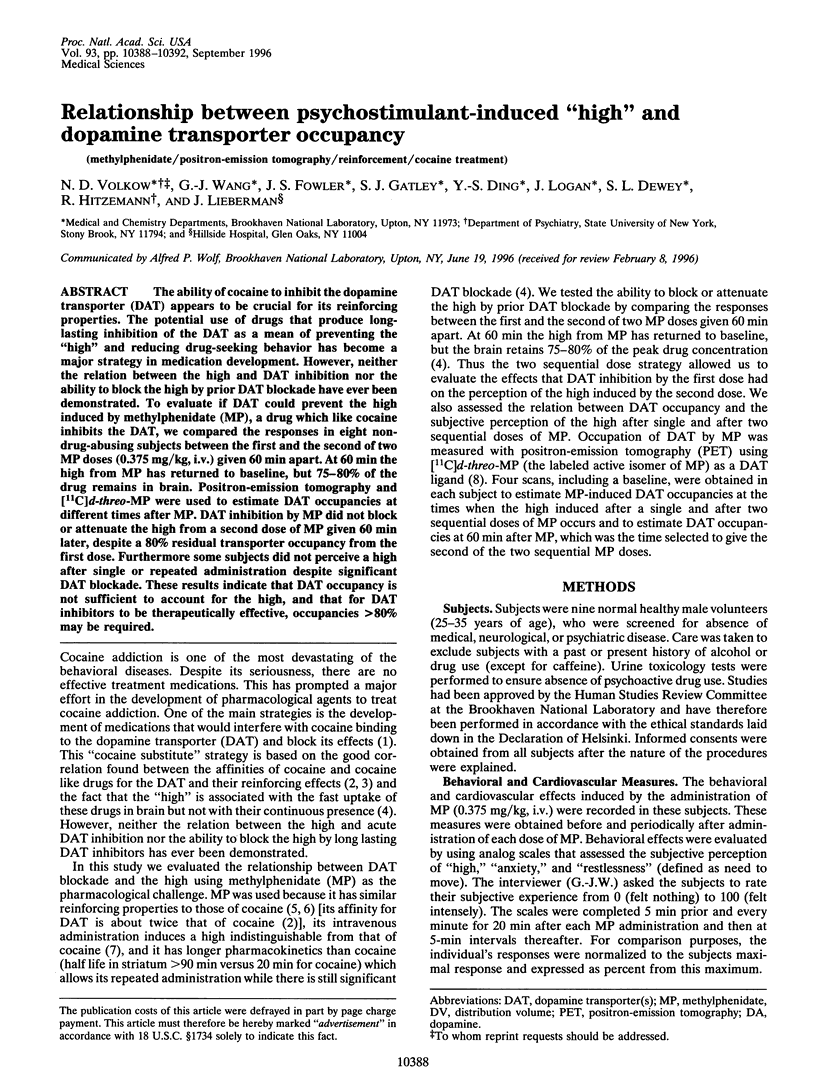
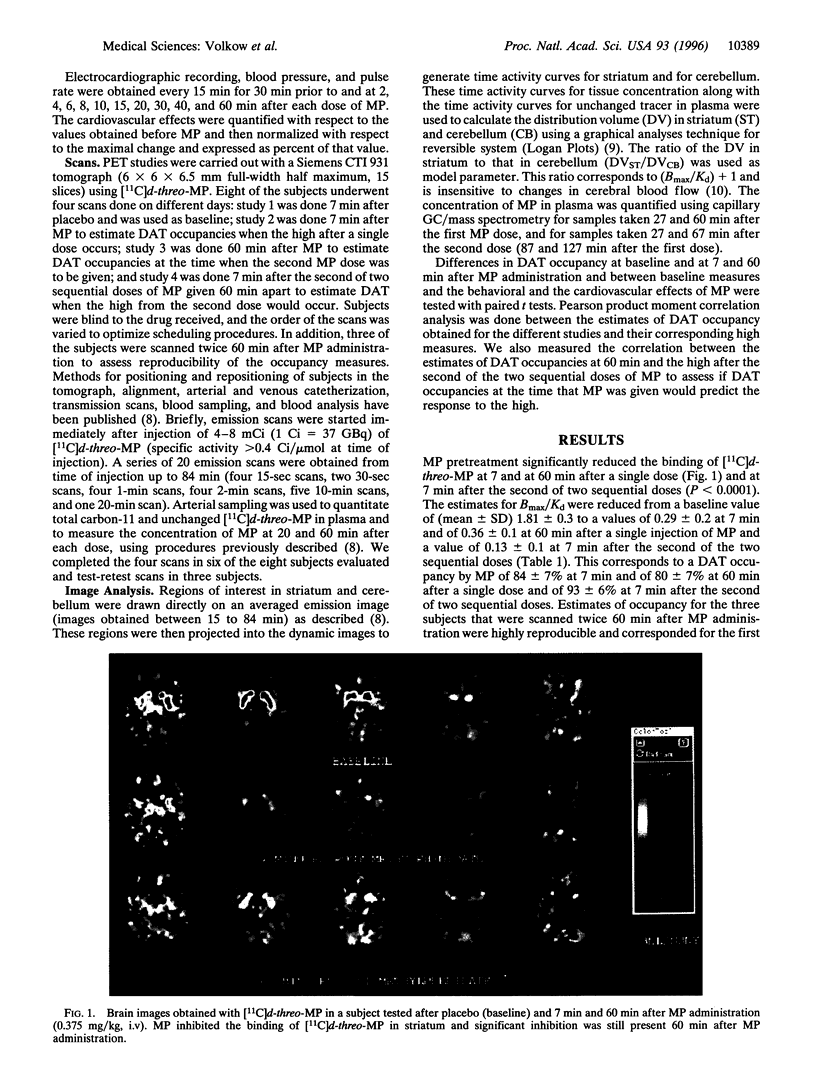
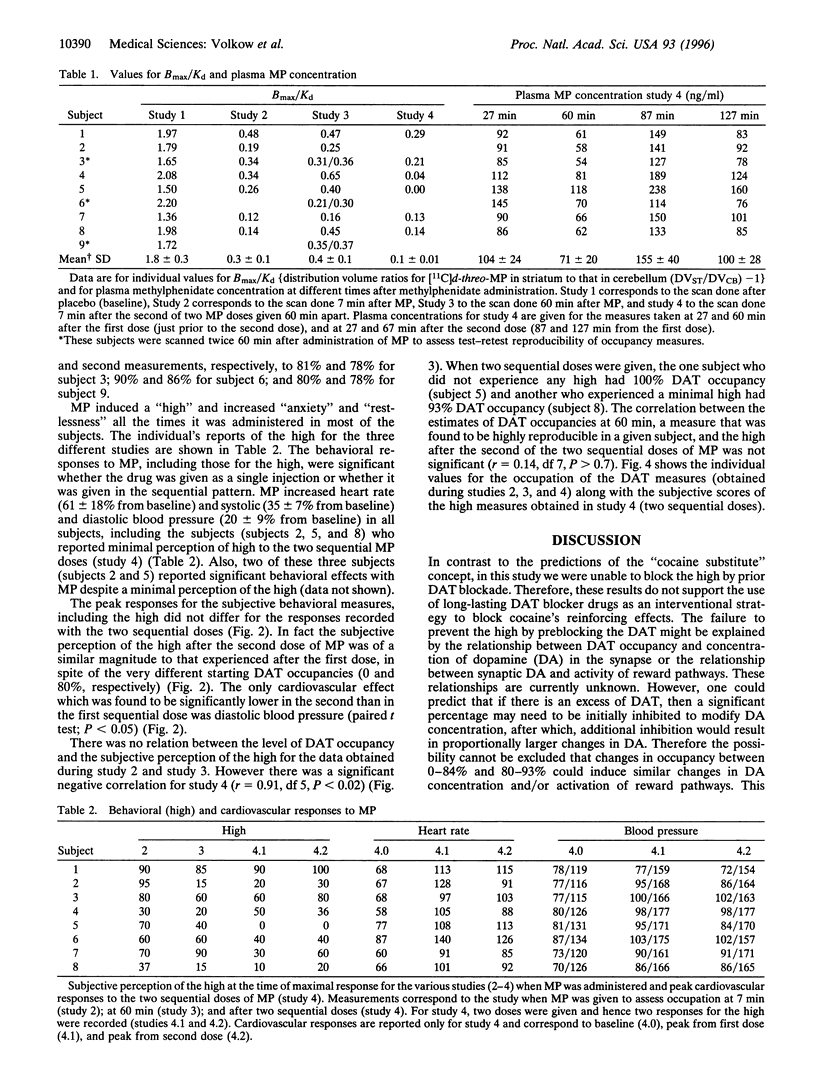
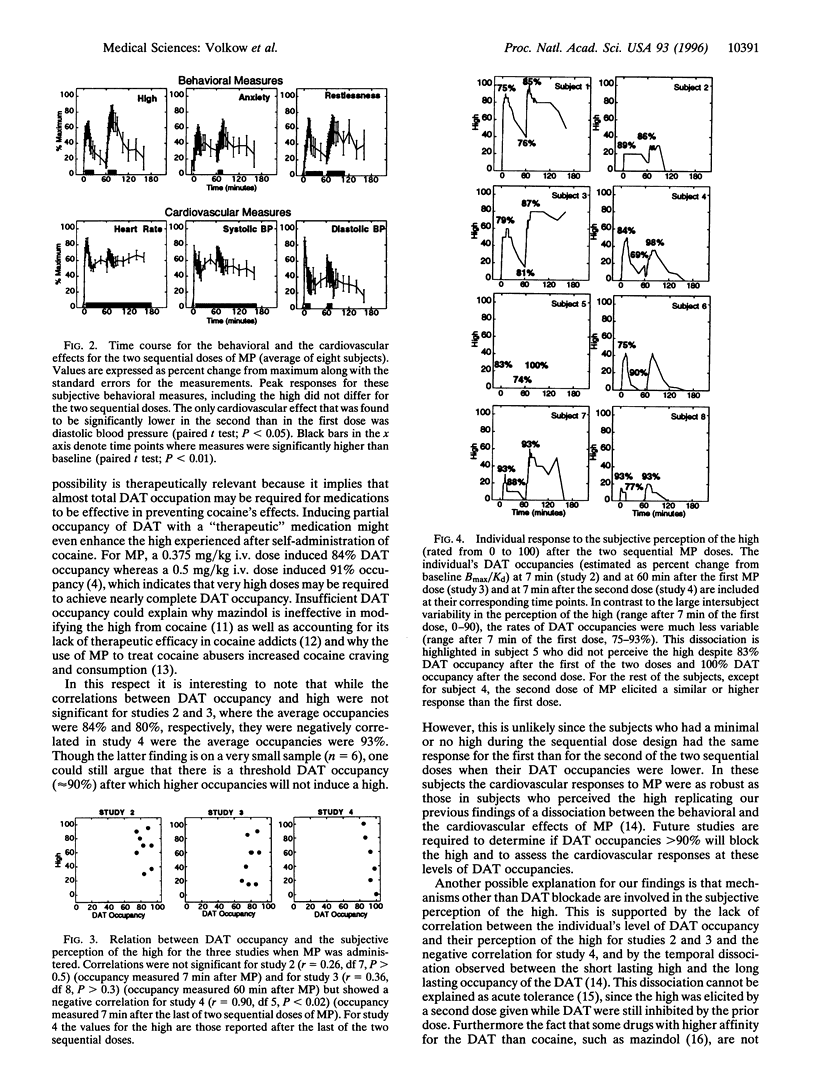
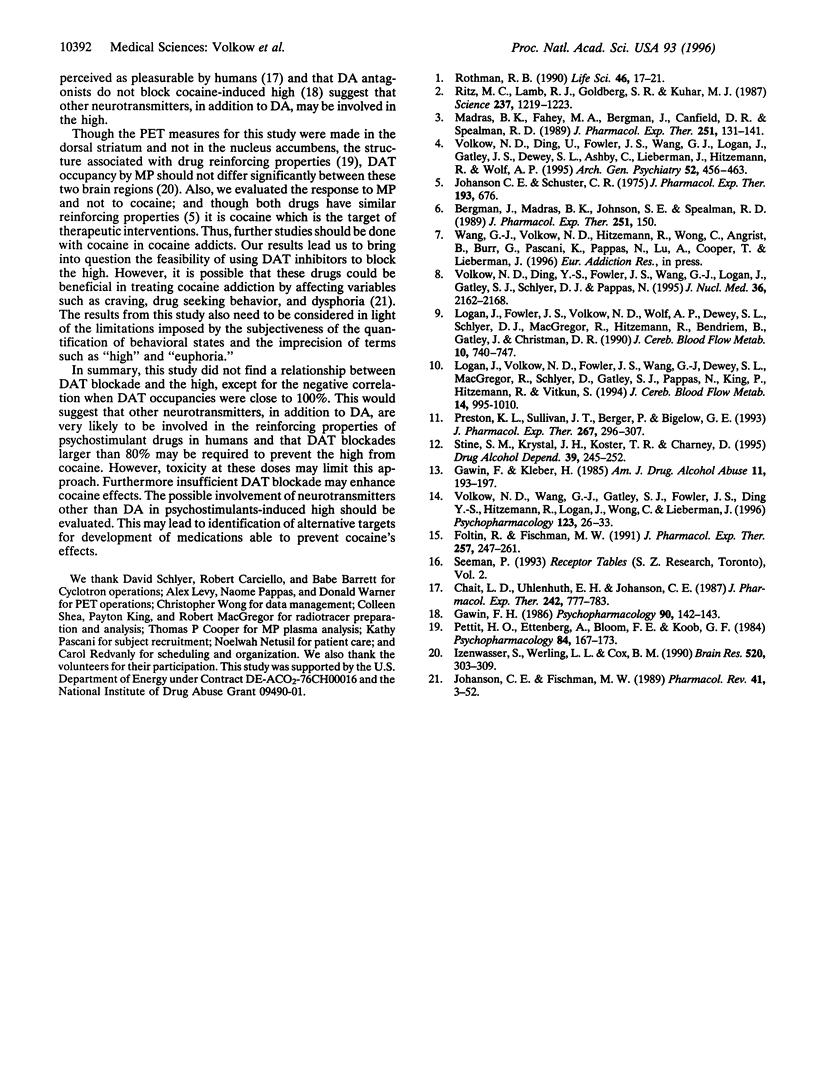
Images in this article
Selected References
These references are in PubMed. This may not be the complete list of references from this article.
- Bergman J., Madras B. K., Johnson S. E., Spealman R. D. Effects of cocaine and related drugs in nonhuman primates. III. Self-administration by squirrel monkeys. J Pharmacol Exp Ther. 1989 Oct;251(1):150–155. [PubMed] [Google Scholar]
- Chait L. D., Uhlenhuth E. H., Johanson C. E. Reinforcing and subjective effects of several anorectics in normal human volunteers. J Pharmacol Exp Ther. 1987 Sep;242(3):777–783. [PubMed] [Google Scholar]
- Foltin R. W., Fischman M. W. Smoked and intravenous cocaine in humans: acute tolerance, cardiovascular and subjective effects. J Pharmacol Exp Ther. 1991 Apr;257(1):247–261. [PubMed] [Google Scholar]
- Gawin F. H. Neuroleptic reduction of cocaine-induced paranoia but not euphoria? Psychopharmacology (Berl) 1986;90(1):142–143. doi: 10.1007/BF00172886. [DOI] [PubMed] [Google Scholar]
- Gawin F., Riordan C., Kleber H. Methylphenidate treatment of cocaine abusers without attention deficit disorder: a negative report. Am J Drug Alcohol Abuse. 1985;11(3-4):193–197. doi: 10.3109/00952998509016861. [DOI] [PubMed] [Google Scholar]
- Izenwasser S., Werling L. L., Cox B. M. Comparison of the effects of cocaine and other inhibitors of dopamine uptake in rat striatum, nucleus accumbens, olfactory tubercle, and medial prefrontal cortex. Brain Res. 1990 Jun 18;520(1-2):303–309. doi: 10.1016/0006-8993(90)91719-w. [DOI] [PubMed] [Google Scholar]
- Johanson C. E., Fischman M. W. The pharmacology of cocaine related to its abuse. Pharmacol Rev. 1989 Mar;41(1):3–52. [PubMed] [Google Scholar]
- Johanson C. E., Schuster C. R. A choice procedure for drug reinforcers: cocaine and methylphenidate in the rhesus monkey. J Pharmacol Exp Ther. 1975 May;193(2):676–688. [PubMed] [Google Scholar]
- Logan J., Fowler J. S., Volkow N. D., Wolf A. P., Dewey S. L., Schlyer D. J., MacGregor R. R., Hitzemann R., Bendriem B., Gatley S. J. Graphical analysis of reversible radioligand binding from time-activity measurements applied to [N-11C-methyl]-(-)-cocaine PET studies in human subjects. J Cereb Blood Flow Metab. 1990 Sep;10(5):740–747. doi: 10.1038/jcbfm.1990.127. [DOI] [PubMed] [Google Scholar]
- Logan J., Volkow N. D., Fowler J. S., Wang G. J., Dewey S. L., MacGregor R., Schlyer D., Gatley S. J., Pappas N., King P. Effects of blood flow on [11C]raclopride binding in the brain: model simulations and kinetic analysis of PET data. J Cereb Blood Flow Metab. 1994 Nov;14(6):995–1010. doi: 10.1038/jcbfm.1994.132. [DOI] [PubMed] [Google Scholar]
- Madras B. K., Fahey M. A., Bergman J., Canfield D. R., Spealman R. D. Effects of cocaine and related drugs in nonhuman primates. I. [3H]cocaine binding sites in caudate-putamen. J Pharmacol Exp Ther. 1989 Oct;251(1):131–141. [PubMed] [Google Scholar]
- Pettit H. O., Ettenberg A., Bloom F. E., Koob G. F. Destruction of dopamine in the nucleus accumbens selectively attenuates cocaine but not heroin self-administration in rats. Psychopharmacology (Berl) 1984;84(2):167–173. doi: 10.1007/BF00427441. [DOI] [PubMed] [Google Scholar]
- Preston K. L., Sullivan J. T., Berger P., Bigelow G. E. Effects of cocaine alone and in combination with mazindol in human cocaine abusers. J Pharmacol Exp Ther. 1993 Oct;267(1):296–307. [PubMed] [Google Scholar]
- Ritz M. C., Lamb R. J., Goldberg S. R., Kuhar M. J. Cocaine receptors on dopamine transporters are related to self-administration of cocaine. Science. 1987 Sep 4;237(4819):1219–1223. doi: 10.1126/science.2820058. [DOI] [PubMed] [Google Scholar]
- Stine S. M., Krystal J. H., Kosten T. R., Charney D. S. Mazindol treatment for cocaine dependence. Drug Alcohol Depend. 1995 Oct;39(3):245–252. doi: 10.1016/0376-8716(95)01174-4. [DOI] [PubMed] [Google Scholar]
- Volkow N. D., Ding Y. S., Fowler J. S., Wang G. J., Logan J., Gatley J. S., Dewey S., Ashby C., Liebermann J., Hitzemann R. Is methylphenidate like cocaine? Studies on their pharmacokinetics and distribution in the human brain. Arch Gen Psychiatry. 1995 Jun;52(6):456–463. doi: 10.1001/archpsyc.1995.03950180042006. [DOI] [PubMed] [Google Scholar]
- Volkow N. D., Ding Y. S., Fowler J. S., Wang G. J., Logan J., Gatley S. J., Schlyer D. J., Pappas N. A new PET ligand for the dopamine transporter: studies in the human brain. J Nucl Med. 1995 Dec;36(12):2162–2168. [PubMed] [Google Scholar]
- Volkow N. D., Wang G. J., Gatley S. J., Fowler J. S., Ding Y. S., Logan J., Hitzemann R., Angrist B., Lieberman J. Temporal relationships between the pharmacokinetics of methylphenidate in the human brain and its behavioral and cardiovascular effects. Psychopharmacology (Berl) 1996 Jan;123(1):26–33. doi: 10.1007/BF02246277. [DOI] [PubMed] [Google Scholar]



